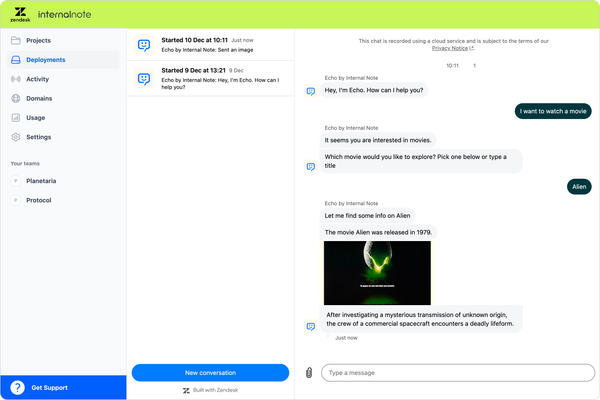
Customer Service Trends 2024 - Zendesk Scorecard
Ultimate has released their Customer Service Trends Report 2024 today. Let's see how close Zendesk aligns with their trends.
Ultimate is a customer support automation platform powered by AI known for its powerful bot and ticket automation capabilities. They have released their Customer Service Trends Report 2024 today highlighting trends in CX for the coming year.
Similar to Zendesk's trend report last year, this report serves as a guide on how you can start building your CX experience vision for next year, and see where your company is up to speed, or lagging behind.

I always find these reports interesting to read since they help place feature releases into a bigger picture and help frame technology as solutions instead of just gimmicks.
Even though most of these kind of reports are build on actual data, they still serve as a marketing tool that directly helps the vendor that releases the insights. There's no better way to promote yourself to potential customers by combining problem, solution and justification in one document. And justifiably so.
So instead of looking at Ultimate's report through the eyes of Ultimate, I thought it would be a fun exercise to take their 7 trends, and see how they compare to Zendesk's current offering. Where can Zendesk assist in following the trends, where does it run short, or where is it a clear winner?
I work for Premium Plus, a Zendesk Premier Partner in EMEA. We are partnered with Ultimate and they send me this report in advance.
None of the content in this article is checked or cleared with them in advance, I just want to use their insights to talk about Zendesk. This is a Zendesk focused blog after all. All opinions are my own.
Seven trends for 2024
The report starts with some preamble about how AI and especially Generative AI has shaken up the CX industry in these last twelve months, and then lists the seven trends according to Ultimate, their customers and a panel of CX Experts that could provide input for the report.
- Customer service becomes the brand
- Try before you buy
- Agent experience takes center stage
- Hybrid reigns supreme
- KB management is key
- Don’t automate at all costs
- AI innovation hits inflection point
Let's see how Zendesk scores for each of these.
Customer service becomes the voice and vision of your brand
By using AI to provide instant support and self-serve tools. By creating seamless experiences across channels. And by ensuring a human is always on hand to provide empathetic care. Support conversations are a crucial touchpoint — and an opportunity to let your brand identity shine. When agents deliver CX that embodies your values, you’ll win first place in customers’ hearts.
This first trend is all about making sure customers get the right experience and support from your company. A good customer experience can make someone an ambassador, a bad experience a detractor. People share the good and the bad with friends, and a trusted brand is a brand where you return too, time and time again.
I think Zendesk is a perfect fit for this trend. The help center, asynchronous conversations, a hybrid model of bots, autoreply and actual human agents make sure customers can both easily self serve their issues, as well as get escalations to the right agent via skill based routing.
And by using both custom Help Center themes, a branded both, and availability of your support on your website, social channels and traditional email or phone, your support can be wherever customers interact with your brand.
My score: A+
Generative AI lowers the barrier to entry for trialing automation tools
Generative AI-powered chatbots work straight out of the box, and more providers are offering businesses free trials so they can test the benefits before committing. And CX leaders are taking them up on it.
If you would have asked me six months ago if Zendesk AI was up to the challenge I would probably have set no. But with the latest AI Drop Zendesk is quickly catching up with the existing big AI Chatbot players.
One of the biggest risks with using any Generative AI model inside of your chatbot is the risk of the model pulling in data and replying with bad or wrong data. I keep going back to this quote from Zuckerberg:
Yeah, so our view is that there’s actually going to be a lot of these that people talk to you for different things. [...] let’s say you’re a small business and you want to have an AI that can help you interface with customers to do sales and support. You want to be pretty confident that your AI isn’t going to be promoting your competitor’s products, right?"
One thing that Zendesk does well is that it purposefully limits the bot to your Help Center and only your Help Center. This gives you two benefits:
- The bot works out of the bot with your data. No training, no content management, if you did your homework with your traditional FAQ, the bot can use that content to answer
- Enabling Generative AI is 2 checkboxes: enabling it + choosing a persona.
There's some limiting factors still at play though: Zendesk's intent models are fixed for an industry and copied across customers with no option for real customisation or training on your actual data. from my testing the models work well if you're in one of the supported industries, but custom models will still give you better results, especially for unique or complex industries.
My score: B+
Agent experience takes center stage as providers build with them in mind
These include generating on-brand replies, analysing message sentiment to help agents adjust the tone of their response, or creating summaries of long message threads [...] More importantly, gen AI makes support teams’ roles more rewarding too. Automating repetitive tasks frees agents to focus on complex cases that require their talents
I think this trend is one where Zendesk is at home, and every Bot company is playing catch up, if we can even consider them playing in the same league.
Zendesk has always been an agent-first platform with the Agent Workspace. They have an omnichannel approach where every channel is turned into a ticket handled in the same interface with context around it.
Now with Zendesk AI you get summary, intelligent triage, suggested tickets and macros, expand and tone shift. These are all items an agent traditionally would need to do manually: categorise, write a summary for team leaders upon escalation, search for related content to resolve an issue, it's all busy work that needed to be done per ticket. When using Zendesk AI I've already seen agent being freed up to only spend time on actually resolving issues, leaving the busy work to the system.
For me, ticket deflection with self service and bots, and agent automation with context and intelligent triage are really two sides of the same coin. When the easy stuff gets solved by the system, you also need to enable your agents to handle the complex stuff. Both in training and resources, as well as making sure they have and get the time to dive deep into these tickets, without wasting time on stuff that AI can automate.
My score: A+
The hybrid approach to support automation unlocks its full potential
Generative AI has taken the world by storm — but that doesn't mean conversation design is out in the cold. The real magic happens when you combine the ease and flexibility of gen AI with the precision and control of conversation design.
I have to admit, I had to read this section of the report twice before I got it. When I glanced over the report the first time I assumed hybrid was about human vs bot. But no, it's about the choice between 100% bot driven, vs human curated flows.
If you rewind a year Zendesk's (and every other bot) approach to flow building was basically this: someone needed to build a flow that, step by step, guided the customer through a fixed path until they reached either a resolution, or got escalated to an agent. We all know these bots: they start with a set of options, and once you ask your question you go down the rabid hole of questions and answers until you get stuck and frustrated. Or, if the intent mapping is done well, and the company has the insights to know where customers get stuck, you get bots with good flows that follow customer logic.
During the AI Drop event last month, Zendesk talked about how the best approach to building a bot is not "go build a hundred flows to tackle each scenario". That doesn't scale and isn't always worth the effort. A better approach is to leverage your existing knowledge base content and generative AI.
Your customers ask any type of question to the bot. The bot uses AI to map the question to an intent, and cross checks with your FAQ content to pull the right information from your articles. It then uses Generative AI to reply with an answer.
Next, you look at your reporting to see what intents are triggered, and where customers clearly are helped or satisfied with the offered bot answers. These flows are ideal for manually crafted flows: you can offer nuance, you can pull in external API date (e.g. Where's my order actually returns a delivery date instead of an article) and prevent issues.
This combination of bot and manual flows is scalable. You can quickly write an article to respond to a question, and moments later the bot will start serving that response to customers. Or you can spend the time to build a full flow for the bigger scenarios.
Zendesk AI has this approach build in with the Intent Suggestions, so they're clearly on the right path here. But since they only offer a fixed set of intents, and you can't add your own, you might be blindsided in your reporting for the stuff Zendesk can't map.
My score: B+
#1 new support skill: Knowledge base management and optimisation
Knowledge base management empowers CS agents to offer better, more streamlined support while also enabling customers to help themselves when and wherever it suits them. And in the age of generative AI, it is absolutely essential your knowledge base is in top form.
For a while now I've made the difference of talking about Knowledge Base when talking about managing content and articles, and Help Center when talking about the website where customers can read content.
Within Zendesk your articles feed your Help Center, are available to Agents in the Context Panel, are offered via email with autoreply to your customers, and are also used to offer a list of articles, or generated replies in your web widget and Zendesk Bot.
So detecting gaps in your knowledge, being able to translate problems into steps to resolve, and keeping the data up to date are foundational skills needed to offer good support to both your customers and agents.
Or to paraphrase a terrible CGI creation from a galaxy far far away:
No content, no articles, no self-serve.

Zendesk Guide has long been a cornerstone of Zendesk's offering, even before Zendesk Suite was a thing, and with content cues and the additional review and publishing features in Suite Enterprise, you've got the basis to manage your content right within our CX toolkit.
My approach to this has been to create a report that pulls in search queries, ticket escalations (so self service failed) and categorised tickets. Then create a weekly report that shows the top 10 and bottom 10 of these there datapoints. And then sure your Help Center captures both the top and bottom ten for each of those datapoints:
- Top 10: the Frequent in FAQ.
- Bottom 10: make sure unique cases are also served so you show your expertise.
My score: A-
Ticket automation becomes a differentiator for the most human CX teams
AI can free your agents from their most repetitive, mundane tasks so they have more capacity to provide better, empathetic support to your customers. [...] the area in greatest need of improvement is eliminating manual tasks like routing and tagging tickets.
I kinda pointed to it in an earlier trend already, but agents should spend time helping customers, and shouldn't lost time doing repeated tasks.
If your platform removed repeated questions from agent queues, makes sure the agents get tickets aligned to their skills (reducing the need for rerouting) and offer full context with intent, sentiment, related tickets and things like purchase history, customer profile e.a., then the agent job is basically solving the issue, and not so much doing a lot of bookkeeping and filling in fields.
Zendesk's omnichannel routing, intelligent triage, Agent Home, triggers and automations are all pieces of the puzzle that forms Agent Workspace.
My score: A+
AI innovation hits inflection point, fast-tracking global business growth
The AI market is rapidly maturing. And the pace of change means we’ve hit a tipping point. Today, the effort-to-reward ratio has dramatically shifted — with AI-powered automation making it easier than ever for brands to scale.
This last one for me is where trends meets marketing. Naturally, every report this year will point out how every tech company threw out their roadmap and realigned their development to include OpenAI's platform into their product.
So it's only natural that the expected trend is that those companies get a return on their work and investment by now pushing customers to start using these AI powered tools. Even when not all of them have proven to actually work, provide good results or what the impact will be in 1, 5 or 10 years of the choses made today.
Criticism aside, I do see the same results and short-term impact that these new AI technologies have made possible, so its an obvious thing to put in a trends report cause it's true, no?
Zendesk itself also jumped on the bandwagon with their two-part Zendesk AI release this year, it remains to be seen how the platform will evolve and integrate more AI tools across their product suite.
Conclusion
I joked (kinda) at the start of this article that most of these trends reports are self-serving to the publisher. But I have to give points to Ultimate for including this one:
Shop around for the right provider - Take a few generative bots for a test ride before committing. Choose an established automation partner that can handle complex use cases, has experience with your industry, and has the flexibility to grow with your company.
It's indeed true that not every provider is the same, and that a single platform can't solve all needs.
When looking at the trends Ultimate proposed my end-score for Zendesk is a solid A-, with the biggest weaknesses in the product the fact that Zendesk only offered prebuilt AI models scoped to a small set of predefined industries: Retail, Tech, Finance, HR, IT and Travel (announced).
These models are based on Zendesk's billions of tickets, but lack the ability to align with the actual intents of a company. Imagine you run public transport company that kinda does retail (tickets, subscriptions), but is also kinda travel (destinations, itineraries)? If that's the case, Zendesk AI's approach isn't a really good fit since the intents kinda align, but don't fully overlap with your actual ticket categories. So that's where purpose-build bot builders with custom intent models currently take a lead.
But when it comes to the other side of the coin, handling escalations to real agents and making their work easier and more rewarding, that's where Zendesk has a clear lead over other platforms.
However you take it, it's nice to see how Zendesk and the market overall seem to be running in the same direction. It gives me confidence in the route the platform has taken.






